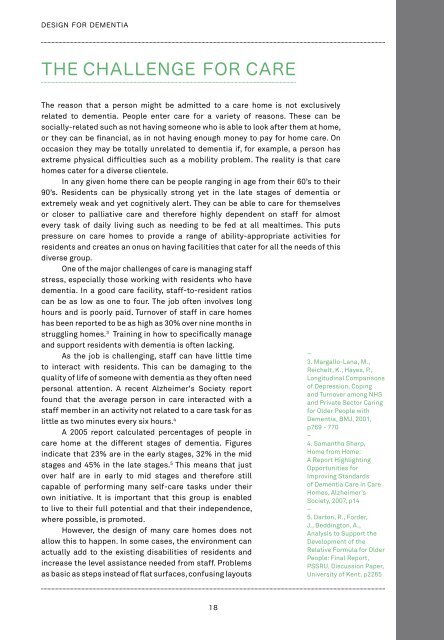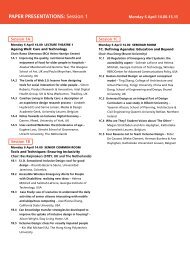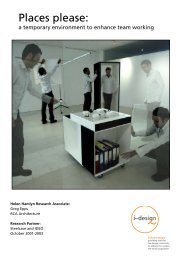Design for Dementia - Helen Hamlyn Centre - Royal College of Art
Design for Dementia - Helen Hamlyn Centre - Royal College of Art
Design for Dementia - Helen Hamlyn Centre - Royal College of Art
You also want an ePaper? Increase the reach of your titles
YUMPU automatically turns print PDFs into web optimized ePapers that Google loves.
DESIGN FOR DEMENTIA<br />
CONTEXT<br />
The Challenge <strong>for</strong> Care<br />
The reason that a person might be admitted to a care home is not exclusively<br />
related to dementia. People enter care <strong>for</strong> a variety <strong>of</strong> reasons. These can be<br />
socially-related such as not having someone who is able to look after them at home,<br />
or they can be financial, as in not having enough money to pay <strong>for</strong> home care. On<br />
occasion they may be totally unrelated to dementia if, <strong>for</strong> example, a person has<br />
extreme physical difficulties such as a mobility problem. The reality is that care<br />
homes cater <strong>for</strong> a diverse clientele.<br />
In any given home there can be people ranging in age from their 60’s to their<br />
90’s. Residents can be physically strong yet in the late stages <strong>of</strong> dementia or<br />
extremely weak and yet cognitively alert. They can be able to care <strong>for</strong> themselves<br />
or closer to palliative care and there<strong>for</strong>e highly dependent on staff <strong>for</strong> almost<br />
every task <strong>of</strong> daily living such as needing to be fed at all mealtimes. This puts<br />
pressure on care homes to provide a range <strong>of</strong> ability-appropriate activities <strong>for</strong><br />
residents and creates an onus on having facilities that cater <strong>for</strong> all the needs <strong>of</strong> this<br />
diverse group.<br />
One <strong>of</strong> the major challenges <strong>of</strong> care is managing staff<br />
stress, especially those working with residents who have<br />
dementia. In a good care facility, staff-to-resident ratios<br />
can be as low as one to four. The job <strong>of</strong>ten involves long<br />
hours and is poorly paid. Turnover <strong>of</strong> staff in care homes<br />
has been reported to be as high as 30% over nine months in<br />
struggling homes. 3 Training in how to specifically manage<br />
and support residents with dementia is <strong>of</strong>ten lacking.<br />
As the job is challenging, staff can have little time<br />
to interact with residents. This can be damaging to the<br />
quality <strong>of</strong> life <strong>of</strong> someone with dementia as they <strong>of</strong>ten need<br />
personal attention. A recent Alzheimer's Society report<br />
found that the average person in care interacted with a<br />
staff member in an activity not related to a care task <strong>for</strong> as<br />
little as two minutes every six hours. 4<br />
A 2005 report calculated percentages <strong>of</strong> people in<br />
care home at the different stages <strong>of</strong> dementia. Figures<br />
indicate that 23% are in the early stages, 32% in the mid<br />
stages and 45% in the late stages. 5 This means that just<br />
over half are in early to mid stages and there<strong>for</strong>e still<br />
capable <strong>of</strong> per<strong>for</strong>ming many self-care tasks under their<br />
own initiative. It is important that this group is enabled<br />
to live to their full potential and that their independence,<br />
where possible, is promoted.<br />
However, the design <strong>of</strong> many care homes does not<br />
allow this to happen. In some cases, the environment can<br />
actually add to the existing disabilities <strong>of</strong> residents and<br />
increase the level assistance needed from staff. Problems<br />
as basic as steps instead <strong>of</strong> flat surfaces, confusing layouts<br />
–<br />
3. Margallo-Lana, M.,<br />
Reichelt, K., Hayes, P.,<br />
Longitudinal Comparisons<br />
<strong>of</strong> Depression, Coping<br />
and Turnover among NHS<br />
and Private Sector Caring<br />
<strong>for</strong> Older People with<br />
<strong>Dementia</strong>, BMJ, 2001,<br />
p769 - 770<br />
–<br />
4. Samantha Sharp,<br />
Home from Home:<br />
A Report Highlighting<br />
Opportunities <strong>for</strong><br />
Improving Standards<br />
<strong>of</strong> <strong>Dementia</strong> Care in Care<br />
Homes, Alzheimer’s<br />
Society, 2007, p14<br />
–<br />
5. Darton, R., Forder,<br />
J., Beddington, A.,<br />
Analysis to Support the<br />
Development <strong>of</strong> the<br />
Relative Formula <strong>for</strong> Older<br />
People: Final Report,<br />
PSSRU, Discussion Paper,<br />
University <strong>of</strong> Kent, p2265<br />
which prevent residents from finding their way or no access to outdoor spaces all<br />
turn actions that could be completed by residents independently into obstacles<br />
that staff have to help them overcome.<br />
One major goal <strong>of</strong> this project has been to develop better design strategies<br />
that help to promote resident independence and improve carer and resident<br />
interaction. By improving a resident’s ability to be more self-sufficient, staff time<br />
is freed up, giving them more opportunity to engage with residents at a social and<br />
personal level. This, in turn, improves quality <strong>of</strong> life <strong>for</strong> residents and can make the<br />
job <strong>for</strong> staff more enjoyable and less stressful.<br />
Independence <strong>for</strong> residents<br />
=<br />
More staff free time<br />
=<br />
Improved social interaction<br />
18<br />
19

















